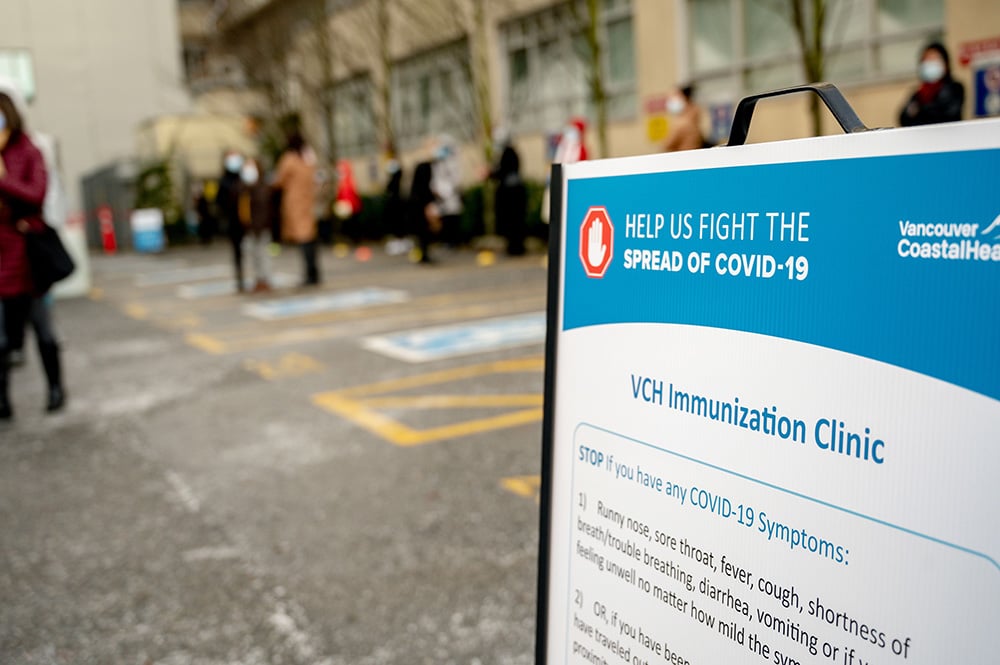Compiled by veteran medical journalist Brian Owens, this roundup of some of the newest science on the COVID-19 pandemic, straight from the scientific journals, is presented by Hakai Magazine in partnership with The Tyee.
Don’t hold back vaccines for the second dose
Both of the vaccines authorized for use in the United States and Canada require two doses to be fully effective. This has led some jurisdictions to reserve half of the vaccine doses they receive to ensure everyone who gets the first dose will get the second on time. But three new studies show that a single dose of vaccine given to twice as many people — even if less effective for each person than two doses — may have greater population benefit until there is enough available to give everyone two doses. These studies suggest it’s more effective to get a first dose into as many people as possible as quickly as possible. Even if this strategy disrupts the vaccination schedule later, partial protection at the individual level will likely lower transmission rates enough to stop epidemic growth.
Annals of Internal Medicine, Jan. 5, 2021 (1)
Annals of Internal Medicine, Jan. 5, 2021 (2)
Annals of Internal Medicine, Jan. 5, 2021 (3)
Vaccines are safe for those with allergies
Reports of allergic reactions to the two COVID-19 vaccines produced by Pfizer and Moderna have raised some concerns among the public, but a team of allergists has reviewed all the available evidence and concluded that they can be safely given even to those with severe food or medication allergies. They note that allergic reactions to vaccines are rare, with a rate of about 1.3 per one million people, and that only those with a history of reactions to an injectable drug or vaccine containing polyethylene glycol or polysorbate should be cautious and speak with their doctor before getting the vaccine.
The Journal of Allergy and Clinical Immunology, Dec. 31, 2020
Why COVID-19 is worse than flu
The way our immune systems respond to COVID-19 may explain why it is more severe than a regular seasonal flu. Researchers at the University of Toronto tested the blood of patients who had recovered from COVID-19 and compared how their immune cells reacted to both SARS-CoV-2 and the common flu virus. They found that immune cells that respond to SARS-CoV-2 make more inflammatory molecules and might be less efficient at eliminating the virus than immune cells that recognize influenza.
Journal of Immunology, Jan. 1, 2021
Masks don’t hide emotions
The proliferation of face masks to control the COVID-19 pandemic is not stopping kids from understanding facial expressions, despite concerns that concealing some non-verbal cues could hamper children’s emotional development. Researchers showed children aged seven to 13 photos of faces displaying sadness, anger, or fear that were unobstructed, covered by a surgical mask, or wearing sunglasses, and asked them to assign an emotion from a list of six options.
Not surprisingly, they did best with uncovered faces, correctly identifying the emotion 66 per cent of the time. But even with a surgical mask they were able to identify the emotion at a rate better than chance. The kids correctly identified sadness about 28 per cent of the time, anger 27 per cent of the time, and fear 18 per cent of the time. (With six options, the odds of randomly guessing correctly are about 17 per cent). Covering different parts of the face affects which emotions are easier to spot. Sunglasses made anger and fear difficult to identify, and fear, often confused with surprise, was also the trickiest for children to spot behind a mask.
Pregnant women don’t pass virus to fetus
The SARS-CoV-2 virus does not appear to be transmitted from mother to fetus before birth. In 64 pregnant women who tested positive for COVID-19, researchers detected no virus in maternal or cord blood, no signs of the virus in placentas, and no evidence of viral transmission to newborns. But they also found that mothers passed on fewer anti-SARS-CoV-2 antibodies through the placenta than expected.
JAMA Network Open, Dec. 22, 2020
Suicides went down overall, except among Black people
Despite predictions that the pandemic and associated lockdowns would lead to an increase in suicides, a study in Maryland found that suicides in the overall population actually dropped relative to previous years. But among Black Marylanders, suicide deaths increased dramatically during the same period. The researchers say this is another example of how the pandemic has disproportionately affected different groups, with lower income and racialized communities hit harder than others.
JAMA Psychiatry, Dec. 16, 2020
Cultural values more important than a leader’s gender in pandemic response
Though the media has heaped praise on countries led by women that have had successful responses to the COVID-19 pandemic, such as New Zealand, a new study has found that having a woman leader does not by itself make a country fare better during the pandemic. Researchers analyzed COVID-19-related deaths across countries led by men and women and found no significant difference in fatality rates.
Cultural values that did affect fatality rates, such as a long-term orientation, a collectivist focus, and fewer power disparities in society, however, do overlap with the cultural values that support female leadership. Given a position of leadership, women are better able to capitalize on those cultural values than men and are more likely to turn those values into pandemic management successes. Countries without those values fare worse, regardless of whether they are led by men or women. The researchers believe the narrative that woman-led countries are better off is a result of Western media bias and a focus on economically advanced countries, such as those in the OECD club of rich countries.

Media coverage of scientific preprints has been uneven
The COVID-19 pandemic has led to an explosion in media reports on scientific studies published as preprints — that is, preliminary results that have not yet been peer reviewed and verified by other scientists. Normally these kinds of publications attract little attention until they have been reviewed and published in a scientific journal, but the urgency of the pandemic meant that journalists had to report on them in the absence of reviewed studies. This has had benefits, as sharing early findings about prevention strategies can help save lives, but also caused problems. For example, an early report that linked smoking with COVID-19 prevention received a lot of coverage, though the finding was later discredited.
Analyzing more than 500 online news reports on preprints, researchers at Simon Fraser University found that only half of the stories made it clear that the research they were reporting on was preliminary, unreviewed, or unverified. Interestingly, established legacy publications like the New York Times or the Guardian were just as inconsistent as newer online publications like Medium. (For this column, I have generally avoided reporting on preprints and kept the focus on papers that have been peer-reviewed. This is because I lack both the necessary skills to properly evaluate all of them myself, and the time to find an expert to examine them for me).
Health Communication, Jan. 3, 2021
Comparing mobility and infection rates in Denmark and Sweden
Denmark was one of the first countries to enforce a lockdown in response to the COVID-19 pandemic, while Sweden had few official restrictions at the beginning of the pandemic. A comparison of mobility data and infection rates between the two countries has found that Denmark’s restrictions resulted in a greater decrease in mobility and fewer daily new cases of disease than Sweden’s more relaxed approach.
JAMA Network Open, Jan. 4, 2021
Pandemic caused more, and faster, psychological distress
The pandemic caused an entire year’s worth of psychological distress in just a couple of months, according to new research. A study of a representative sample of people in the United States found that 10 per cent reported experiencing symptoms of significant psychological distress during April and May of 2020 — the same proportion that reported experiencing it at some point during the entire previous year. The study also found that people with distress prior to the pandemic were more likely to report distress during the pandemic. Among people with severe distress prior to the pandemic, 48 per cent reported distress during the pandemic. Among people with low or no distress prior to the pandemic, just three per cent reported distress during the pandemic.
Preventive Medicine, Dec. 31, 2020
School can be safe with the right procedures in place
A study of schools in Chicago, Ill., where public schools are using virtual learning, but private ones are open, has found that with good mitigation procedures the risk of transmission in schools appears lower than outside of school. The estimated COVID-19 attack rate (the percentage of an at-risk population that contracts the disease during a specified time interval) among students at private schools in the first seven weeks of the 2020-21 school year was 0.2 per cent, significantly lower than the 0.4 per cent rate for all Chicago children. For school staff, the estimated attack rate was 0.5 per cent, compared to 0.7 per cent for working-age adults in the city.
Journal of Public Health Management and Practice, Dec. 30, 2020
Telemedicine increased, but access was uneven
While the COVID-19 pandemic has resulted in a huge expansion in the number of patients having medical appointments via telemedicine, access to virtual visits has been uneven, with some groups less able to access the services. Researchers in the United States looked at almost 150,000 patients who were scheduled for in-person visits between March and May 2020. Of these, more than half, 81,000 people, conducted their appointment by telemedicine, with less than half of those, 36,000, using video.
The researchers found some clear iniquities within those numbers. People older than 55 were 25 per cent less likely than average to use telemedicine, and those older than 75 were 33 per cent less likely. Asian-Americans were 31 per cent less likely to conduct a telemedicine visit, and those who did not speak English were 16 per cent less likely. Older people were even less likely to use video, and some groups who did not seem to have problems accessing phone-based telemedicine, such as Black people and those with lower incomes, seemed to have less access to video-based telemedicine.
JAMA Network Open, Dec. 29, 2020 ![]()
Read more: Coronavirus, Science + Tech
















Tyee Commenting Guidelines
Comments that violate guidelines risk being deleted, and violations may result in a temporary or permanent user ban. Maintain the spirit of good conversation to stay in the discussion.
*Please note The Tyee is not a forum for spreading misinformation about COVID-19, denying its existence or minimizing its risk to public health.
Do:
Do not: